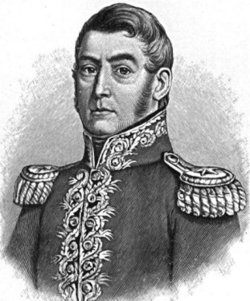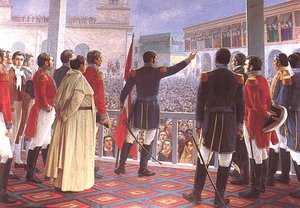|
|
José de San Martín (25 February, 1778 – 17 August, 1850) was an Argentine general and the prime leader of the southern part of South America's successful struggle for independence from Spain.
Together with Simón Bolívar in the north, San Martín is regarded as one of the Liberators of Spanish South America. He is a national hero of Argentina.
San Martín was born in the town of Yapeyu in the Corrientes Province of Argentina, then a Spanish colony. His father was a Spanish official. He was educated at the military academy in Madrid, commissioned as a Second Lieutenant in 1793, and rose to Lieutenant Colonel in 1808. He fought with the Spanish army against Portugal, in the African colonies, and against the invasion by Napoleon I's forces. In 1812 he resigned from the Spanish army and sailed home to Argentina, where he offered his services to the revolutionary forces.
He led the rebels to victory over the Spanish forces under General José Zavala at the Battle of San Lorenzo de Parana in February 1813. San Martín was given the rank of General by the revolutionary government. The following year he took command of the northern army preparing a new invasion of Upper Perú (now Bolivia), a command he resigned to become governor of the province of Cuyo (now the provinces of Mendoza, San Juan, and San Luis Province), from where he attacked the Spaniards in Chile at the beginning of 1817. With Bernardo O'Higgins, he made a triumphant entry into the liberated city of Santiago de Chile on 17 March, 1818.
Next, San Martín turned his attention to the Spanish stronghold of Peru. For more than two years he prepared the Navy to attempt an invasion. After months of slow advances, he won a decisive victory at the Battle of Pisco on 6 December, 1820. The Spanish Viceroy tried to negotiate terms, but as he would not concede complete independence, San Martín turned him down.
San Martín occupied Lima on 9 July, 1821. On 28 July he was voted the "Protector" of the newly independent nation of Peru. During the same year, he founded the National Library of Peru, where he donated his collection of books and praised the new library as: "... one of the most efficient mediums to place into circulation our intellectual values".
After Peru's parliament had been assembled, he resigned his command.
Sanmartin.JPG
On 26 July, 1822 he met with Simón Bolívar at Guayaquil to plan the future of Latin America. Most of the details of this meeting were secret at the time, and this has made the event a matter of much debate among later historians. Some believe that apparently Bolívar's refusal to share command of the combined forces may have contributed to leading San Martín to subsequently withdraw from Perú and settle as a farmer in Mendoza, Argentina.
5pesos.jpg
In 1824, after the death of his wife, Remedios de Escalada, he moved to France with his daughter, where he spent the remainder of his days retired at Boulogne-sur-Mer.
In 1880 his remains were taken to Buenos Aires and reinterred in the Buenos Aires Cathedral.
See also
- ΦΙΑ – A U.S. university fraternity that takes José de San Martín as one of its "five pillars"es:José de San Martín


